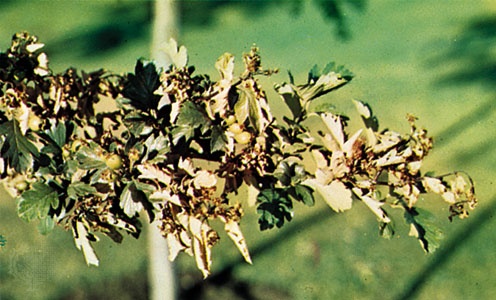fire blight
disease
 plant disease caused by the bacterium Erwinia amylovora, which has destroyed pear and apple orchards in much of North America, parts of Europe, New Zealand, and Japan. Other plants affected include almond, Amelanchier, apricot, aronia, cherry, Cotoneaster, crab apple, hawthorn, Holodiscus, Japanese quince, loquat, medlar, mountain ash, Photinia, plum, Potentilla, Pyracantha, quince, raspberry, rose, spiraea, and other plants in the family Rosaceae. Symptoms include a sudden, brown to black withering and dying of blossoms, fruit spurs, leaves, twigs, and branches. Very susceptible pears, apples, crab apples (crab apple), and quinces (quince) appear as if scorched by fire and may die. Slightly sunken, encircling, dark-brown to purplish-black cankers with a sharp, often cracked margin form on twigs, branches, and trunk, causing a terminal dieback. Fruits are water-soaked, later turning brown or black and shrivelled. In warm, moist spring weather, droplets of bacterial ooze appear on the surface of “holdover” cankers. The oozing bacteria are carried by insects, wind, and rain to infect blossoms, leaves, and twigs. The bacteria spread intercellularly and up to four feet (more than a metre) through vascular tissue in the wood, during late spring and early summer, darkening and killing the tissue. A small percentage of the bacteria overwinter at the margins of branch and trunk cankers ready to repeat the disease cycle starting the following spring about blossoming time.
plant disease caused by the bacterium Erwinia amylovora, which has destroyed pear and apple orchards in much of North America, parts of Europe, New Zealand, and Japan. Other plants affected include almond, Amelanchier, apricot, aronia, cherry, Cotoneaster, crab apple, hawthorn, Holodiscus, Japanese quince, loquat, medlar, mountain ash, Photinia, plum, Potentilla, Pyracantha, quince, raspberry, rose, spiraea, and other plants in the family Rosaceae. Symptoms include a sudden, brown to black withering and dying of blossoms, fruit spurs, leaves, twigs, and branches. Very susceptible pears, apples, crab apples (crab apple), and quinces (quince) appear as if scorched by fire and may die. Slightly sunken, encircling, dark-brown to purplish-black cankers with a sharp, often cracked margin form on twigs, branches, and trunk, causing a terminal dieback. Fruits are water-soaked, later turning brown or black and shrivelled. In warm, moist spring weather, droplets of bacterial ooze appear on the surface of “holdover” cankers. The oozing bacteria are carried by insects, wind, and rain to infect blossoms, leaves, and twigs. The bacteria spread intercellularly and up to four feet (more than a metre) through vascular tissue in the wood, during late spring and early summer, darkening and killing the tissue. A small percentage of the bacteria overwinter at the margins of branch and trunk cankers ready to repeat the disease cycle starting the following spring about blossoming time. - Saint Sabas
- Saints Anne and Joachim
- Saint Sarapion
- Saint Sava
- Saint-Saëns, Camille
- Saintsbury, George
- saints, communion of
- Saints Cosmas and Damian
- Saints Crispin and Crispinian
- Saints Cyril and Methodius
- Saint Sebastian
- Saint Seraphim of Sarov
- Saint Sergius I
- Saint Sergius of Radonezh
- Saint Silas
- Saint Silverius
- Saint Simeon Stylites
- Saint-Simon, Henri de
- Saint-Simon, Louis de Rouvroy, Duke de
- Saint Simon the Apostle
- Saint Simplicius
- Saint Siricius
- Saint Sixtus I
- Saint Sixtus II
- Saint Sixtus III